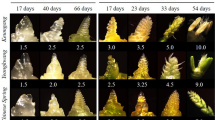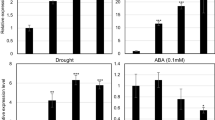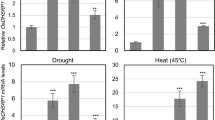Abstract
Heat stress accelerates abnormal maturation and leads to numerous defects in wheat. Temperature determines the duration of plant growth and heat stress accelerates crop development, resulting in premature initiation of phenological stages. The grain filling period is sensitive and is easily exposed to heat stress, which reduces the grain weight and shortens the period. In this study, from anthesis through early spike maturity, we observed decreased grain weight and accelerated maturation under heat stress, resulting in poor grain development. Furthermore, the maturation of spikes was accelerated to shorten the grain filling and ripening periods under high temperatures. Triticum aestivum L. UBOX responding Heat Stress gene (TaUHS) (TraesCS1D02G145900, UBOX response heat stress) was highly expressed in grains located at the basal positions of the spike under high-temperature stress. TaUHS is an E3 ligase found in the nucleus and plasma membrane. We demonstrated that TaUHS interacts with Triticum aestivum L. LEA containing seed development gene (TaLSD) (TraesCS5A02G385600, LEA-containing seed development). TaLSD, which played stress resistance and desiccation tolerance at grain filling period, mediates ubiquitination and proteasomal degradation by 26S proteasome with TaUHS under high-temperature conditions. Proteolysis of TaLSD in conjugate with E3 ligase might occur to maintain cellular homeostasis and stability in response to unfavorable environmental conditions. Wheat RING/U-BOX E3 ligase negatively regulates late embryogenesis-abundant proteins during the grain filling period under heat stress.








Similar content being viewed by others
Data availability
The FASTQ fles of raw data were uploaded to the NCBI Sequence Read Archive (SRA), and the SRA study accession is PRJNA877088.
References
Anders S, Pyl PT, Huber W (2015) HTSeq—a Python framework to work with high-throughput sequencing data. Bioinformatics 31(2):166–169
Angelovici R, Galili G, Fernie AR, Fait A (2010) Seed desiccation: a bridge between maturation and germination. Trends Plant Sci 15(4):211–218
Bu Q, Li H, Zhao Q, Jiang H, Zhai Q, Zhang J, Wu X, Sun J, Xie Q, Wang D (2009) The Arabidopsis RING finger E3 ligase RHA2a is a novel positive regulator of abscisic acid signaling during seed germination and early seedling development. Plant Physiol 150(1):463–481
Candat A, Paszkiewicz G, Neveu M, Gautier R, Logan DC, Avelange-Macherel M-H, Macherel D (2014) The ubiquitous distribution of late embryogenesis abundant proteins across cell compartments in Arabidopsis offers tailored protection against abiotic stress. Plant Cell 26(7):3148–3166
Chan S-P, Kao D-I, Tsai W-Y, Cheng S-C (2003) The Prp19p-associated complex in spliceosome activation. Science 302(5643):279–282
Chauhan H, Khurana N, Tyagi AK, Khurana JP, Khurana P (2011) Identification and characterization of high temperature stress responsive genes in bread wheat (Triticum aestivum L.) and their regulation at various stages of development. Plant Mol Biol 75(1):35–51
Chen H, Nelson R, Sherwood J (1994) Enhanced recovery of transformants of Agrobacterium tumefaciens after freeze-thaw transformation and drug selection. Biotechniques 16(4):664–668
Chen L, Wang Z, Li M, Ma X, Tian E, Sun A, Yin Y (2018) Analysis of the natural dehydration mechanism during middle and late stages of wheat seeds development by some physiological traits and iTRAQ-based proteomic. J Cereal Sci 80:102–110
Ciechanover A (1998) The ubiquitin–proteasome pathway: on protein death and cell life. EMBO J 17(24):7151–7160
Cox MP, Peterson DA, Biggs PJ (2010) SolexaQA: At-a-glance quality assessment of Illumina second-generation sequencing data. BMC Bioinformatics 11(1):1–6
Crowe JH, Hoekstra FA, Crowe LM (1992) Anhydrobiosis. Annu Rev Physiol 54(1):579–599
Dias A, Lidon F (2009) Evaluation of grain filling rate and duration in bread and durum wheat, under heat stress after anthesis. J Agron Crop Sci 195(2):137–147
Dreccer MF, Wockner KB, Palta JA, McIntyre CL, Borgognone MG, Bourgault M, Reynolds M, Miralles DJ (2014) More fertile florets and grains per spike can be achieved at higher temperature in wheat lines with high spike biomass and sugar content at booting. Funct Plant Biol 41(5):482–495
Du L, Li N, Chen L, Xu Y, Li Y, Zhang Y, Li C, Li Y (2014) The ubiquitin receptor DA1 regulates seed and organ size by modulating the stability of the ubiquitin-specific protease UBP15/SOD2 in Arabidopsis. Plant Cell 26(2):665–677
Duan J, Cai W (2012) OsLEA3-2, an abiotic stress induced gene of rice plays a key role in salt and drought tolerance. PLoS ONE 7(9):e45117
Dure L III, Greenway SC, Galau GA (1981) Developmental biochemistry of cottonseed embryogenesis and germination: changing messenger ribonucleic acid populations as shown by in vitro and in vivo protein synthesis. Biochemistry 20(14):4162–4168
Dure L, Crouch M, Harada J, Ho T-HD, Mundy J, Quatrano R, Thomas T, Sung Z (1989) Common amino acid sequence domains among the LEA proteins of higher plants. Plant Mol Biol 12(5):475–486
Farooq M, Bramley H, Palta JA, Siddique KH (2011) Heat stress in wheat during reproductive and grain-filling phases. Crit Rev Plant Sci 30(6):491–507
Fischer R, Byerlee D (1991) Trends of wheat production in warmer areas: issues and economic consideration. Wheat for non-traditional, warm areas. CIMMYT, Mexico, p 322
Gallardo P, Real-Calderón P, Flor-Parra I, Salas-Pino S, Daga RR (2020) Acute heat stress leads to reversible aggregation of nuclear proteins into nucleolar rings in fission yeast. Cell Rep 33(6):108377
Goel A, Goel AK, Sheoran IS (2003) Changes in oxidative stress enzymes during artificial ageing in cotton (Gossypium hirsutum L.) seeds. J Plant Physiol 160(9):1093–1100
Goyal K, Walton LJ, Tunnacliffe A (2005) LEA proteins prevent protein aggregation due to water stress. Biochem J 388(1):151–157
Halford NG, Curtis TY, Chen Z, Huang J (2015) Effects of abiotic stress and crop management on cereal grain composition: implications for food quality and safety. J Exp Bot 66(5):1145–1156
Hatakeyama S, Yada M, Matsumoto M, Ishida N, Nakayama K-I (2001) U box proteins as a new family of ubiquitin-protein ligases. J Biol Chem 276(35):33111–33120
Henriques J, Moustacchi E (1980) Isolation and characterization of pso mutants sensitive to photo-addition of psoralen derivatives in Saccharomyces cerevisiae. Genetics 95(2):273–288
Hong MJ, Kim J-B, Seo YW, Kim DY (2021) Regulation of glycosylphosphatidylinositol-anchored protein (GPI-AP) expression by F-Box/LRR-repeat (FBXL) protein in wheat (Triticum aestivum L.). Plants 10(8):1606
Houde M, Dallaire S, N’Dong D, Sarhan F (2004) Overexpression of the acidic dehydrin WCOR410 improves freezing tolerance in transgenic strawberry leaves. Plant Biotechnol J 2(5):381–387
Ingram J, Bartels D (1996) The molecular basis of dehydration tolerance in plants. Annu Rev Plant Biol 47(1):377–403
Kaur M, Bhagi P, Gupta AK, Zhawar VK (2013) Antioxidant potential and expression of Lea genes under heat stress in two wheat cultivars differing in heat tolerance. Plant Stress 7(1):19–29
Kim D, Langmead B, Salzberg SL (2015) HISAT: a fast spliced aligner with low memory requirements. Nat Methods 12(4):357–360
Kim DY, Lee YJ, Hong MJ, Kim JH, Seo YW (2021a) Genome wide analysis of U-box E3 ubiquitin ligases in wheat (Triticum aestivum L.). Int J Mol Sci 22(5):2699
Kim JH, Khan IU, Lee CW, Kim DY, Jang CS, Lim SD, Park YC, Kim JH, Seo YW (2021b) Identification and analysis of a differentially expressed wheat RING-type E3 ligase in spike primordia development during post-vernalization. Plant Cell Rep 40(3):543–558
Kim JH, Lee JE, Jang CS (2021c) Regulation of Oryza sativa molybdate transporter1; 3 degradation via RING finger E3 ligase OsAIR3. J Plant Physiol 264:153484
Ko CS, Kim J-B, Hong MJ, Seo YW (2021) Wheat (Triticum aestivum L.) TaHMW1D transcript variants are highly expressed in response to heat stress and in grains located in distal part of the spike. Plants 10(4):687
Kovacs D, Kalmar E, Torok Z, Tompa P (2008) Chaperone activity of ERD10 and ERD14, two disordered stress-related plant proteins. Plant Physiol 147(1):381–390
Kurepa J, Toh-e A, Smalle JA (2008) 26S proteasome regulatory particle mutants have increased oxidative stress tolerance. Plant J 53(1):102–114
Li Y, Zheng L, Corke F, Smith C, Bevan MW (2008) Control of final seed and organ size by the DA1 gene family in Arabidopsis thaliana. Genes Dev 22(10):1331–1336
Ling H, Zeng X, Guo S (2016) Functional insights into the late embryogenesis abundant (LEA) protein family from Dendrobium officinale (Orchidaceae) using an Escherichia coli system. Sci Rep 6(1):1–9
Love M, Anders S, Huber W (2016) DESeq2 vignette. Genome Biol 15:110
Makarov EM, Makarova OV, Urlaub H, Gentzel M, Will CL, Wilm M, Lührmann R (2002) Small nuclear ribonucleoprotein remodeling during catalytic activation of the spliceosome. Science 298(5601):2205–2208
Manfre AJ, Lanni LM, Marcotte WR Jr (2006) The Arabidopsis group 1 LATE EMBRYOGENESIS ABUNDANT protein ATEM6 is required for normal seed development. Plant Physiol 140(1):140–149
Meng L, Feldman L (2010) A rapid TRIzol-based two-step method for DNA-free RNA extraction from Arabidopsis siliques and dry seeds. Wiley
NDong C, Danyluk J, Wilson KE, Pocock T, Huner NP, Sarhan F (2002) Cold-regulated cereal chloroplast late embryogenesis abundant-like proteins. Molecular characterization and functional analyses. Plant Physiol 129(3):1368–1381
Nelson SK, Ariizumi T, Steber CM (2017) Biology in the dry seed: transcriptome changes associated with dry seed dormancy and dormancy loss in the Arabidopsis GA-insensitive sleepy1-2 mutant. Front Plant Sci 8:2158
Nicolas ME, Gleadow RM, Dalling MJ (1984) Effects of drought and high temperature on grain growth in wheat. Funct Plant Biol 11(6):553–566
Ohi R, McCollum D, Hirani B, Den Haese G, Zhang X, Burke J, Turner K, Gould K (1994) The Schizosaccharomyces pombe cdc5+ gene encodes an essential protein with homology to c-Myb. EMBO J 13(2):471–483
Ohi MD, Vander Kooi CW, Rosenberg JA, Chazin WJ, Gould KL (2003) Structural insights into the U-box, a domain associated with multi-ubiquitination. Nat Struct Mol Biol 10(4):250–255
Olvera-Carrillo Y, Campos F, Reyes JL, Garciarrubio A, Covarrubias AA (2010) Functional analysis of the group 4 late embryogenesis abundant proteins reveals their relevance in the adaptive response during water deficit in Arabidopsis. Plant Physiol 154(1):373–390
Palma K, Zhao Q, Cheng YT, Bi D, Monaghan J, Cheng W, Zhang Y, Li X (2007) Regulation of plant innate immunity by three proteins in a complex conserved across the plant and animal kingdoms. Genes Dev 21(12):1484–1493
Prasad PV, Pisipati S, Ristic Z, Bukovnik U, Fritz A (2008) Impact of nighttime temperature on physiology and growth of spring wheat. Crop Sci 48(6):2372–2380
Ruelland E, Zachowski A (2010) How plants sense temperature. Environ Exp Bot 69(3):225–232
Saini H, Aspinall D (1982) Abnormal sporogenesis in wheat (Triticum aestivum L.) induced by short periods of high temperature. Ann Bot 49(6):835–846
Serrano I, Campos L, Rivas S (2018) Roles of E3 ubiquitin-ligases in nuclear protein homeostasis during plant stress responses. Front Plant Sci 9:139
Sofield I, Evans L, Cook M, Wardlaw IF (1977) Factors influencing the rate and duration of grain filling in wheat. Funct Plant Biol 4(5):785–797
Song X-J, Huang W, Shi M, Zhu M-Z, Lin H-X (2007) A QTL for rice grain width and weight encodes a previously unknown RING-type E3 ubiquitin ligase. Nat Genet 39(5):623–630
Song EJ, Werner SL, Neubauer J, Stegmeier F, Aspden J, Rio D, Harper JW, Elledge SJ, Kirschner MW, Rape M (2010) The Prp19 complex and the Usp4Sart3 deubiquitinating enzyme control reversible ubiquitination at the spliceosome. Genes Dev 24(13):1434–1447
Suzuki N (2016) Hormone signaling pathways under stress combinations. Plant Signal Behav 11(11):e1247139
Tashiro T, Wardlaw IF (1989) A comparison of the effect of high temperature on grain development in wheat and rice. Ann Bot 64(1):59–65
Teixeira EI, Fischer G, Van Velthuizen H, Walter C, Ewert F (2013) Global hot-spots of heat stress on agricultural crops due to climate change. Agric for Meteorol 170:206–215
Tewolde H, Fernandez C, Erickson C (2006) Wheat cultivars adapted to post-heading high temperature stress. J Agron Crop Sci 192(2):111–120
Tunnacliffe A, Wise MJ (2007) The continuing conundrum of the LEA proteins. Naturwissenschaften 94(10):791–812
Vander Kooi CW, Ren L, Xu P, Ohi MD, Gould KL, Chazin WJ (2010) The Prp19 WD40 domain contains a conserved protein interaction region essential for its function. Structure 18(5):584–593
Vierstra RD (2009) The ubiquitin–26S proteasome system at the nexus of plant biology. Nat Rev Mol Cell Biol 10(6):385–397
Wang J, Wang R, Mao X, Zhang J, Liu Y, Xie Q, Yang X, Chang X, Li C, Zhang X (2020) RING finger ubiquitin E3 ligase gene TaSDIR1-4A contributes to determination of grain size in common wheat. J Exp Bot 71(18):5377–5388
West M, Harada JJ (1993) Embryogenesis in higher plants: an overview. Plant Cell 5(10):1361
Xia T, Li N, Dumenil J, Li J, Kamenski A, Bevan MW, Gao F, Li Y (2013) The ubiquitin receptor DA1 interacts with the E3 ubiquitin ligase DA2 to regulate seed and organ size in Arabidopsis. Plant Cell 25(9):3347–3359
Xu J, Zhang Y, Guan Z, Wei W, Han L, Chai T (2008) Expression and function of two dehydrins under environmental stresses in Brassica juncea L. Mol Breeding 21(4):431–438
Xu L, Ménard R, Berr A, Fuchs J, Cognat V, Meyer D, Shen WH (2009) The E2 ubiquitin-conjugating enzymes, AtUBC1 and AtUBC2, play redundant roles and are involved in activation of FLC expression and repression of flowering in Arabidopsis thaliana. Plant J 57(2):279–288
Yamaguchi H, Hsu J, Hung M-C (2012) Regulation of ubiquitination-mediated protein degradation by survival kinases in cancer. Front Oncol 2:15
Yassin M, Fara SA, Hossain A, Saneoka H, El Sabagh A (2019) Assessment of salinity tolerance bread wheat genotypes: using stress tolerance indices. Fresenius Environ Bull 28(5):4199–4217
Yee D, Goring DR (2009) The diversity of plant U-box E3 ubiquitin ligases: from upstream activators to downstream target substrates. J Exp Bot 60(4):1109–1121
Zahedi M, Jenner CF (2003) Analysis of effects in wheat of high temperature on grain filling attributes estimated from mathematical models of grain filling. J Agric Sci 141(2):203–212
Acknowledgements
This work was supported by a Korea University grant.
Funding
Funding was provided by Cooperative Research Program for Agriculture Science & Technology Development (Grant No. PJ015705), Basic Science Research Program through the National Research Foundation of Korea (Grant No. 2019R1I1A1A01059968, NRF), Ministry of Science, ICT & Future Planning (Grant No. 2017R1D1A1B06030349).
Author information
Authors and Affiliations
Contributions
CSK and YWS conceived and designed the study. CSK and J-BK designed the experiments to treat the plants. CSK, JSL, and MJH conducted the experiments. CSK and DYK contributed to analytical tools. CSK analyzed the data and wrote the first draft of the manuscript. All authors commented on previous versions of the manuscript. All authors read and approved the manuscript.
Corresponding author
Ethics declarations
Competing interests
The authors declare that they have no competing interests.
Additional information
Communicated by Guoping Zhang.
Publisher's Note
Springer Nature remains neutral with regard to jurisdictional claims in published maps and institutional affiliations.
Supplementary Information
Below is the link to the electronic supplementary material.
Rights and permissions
Springer Nature or its licensor holds exclusive rights to this article under a publishing agreement with the author(s) or other rightsholder(s); author self-archiving of the accepted manuscript version of this article is solely governed by the terms of such publishing agreement and applicable law.
About this article
Cite this article
Ko, C.S., Kim, D.Y., Lee, J.S. et al. Heat-induced RING/U-BOX E3 ligase, TaUHS, is a negative regulator by facilitating TaLSD degradation during the grain filling period in wheat. Plant Growth Regul 99, 251–264 (2023). https://doi.org/10.1007/s10725-022-00902-0
Received:
Accepted:
Published:
Issue Date:
DOI: https://doi.org/10.1007/s10725-022-00902-0




